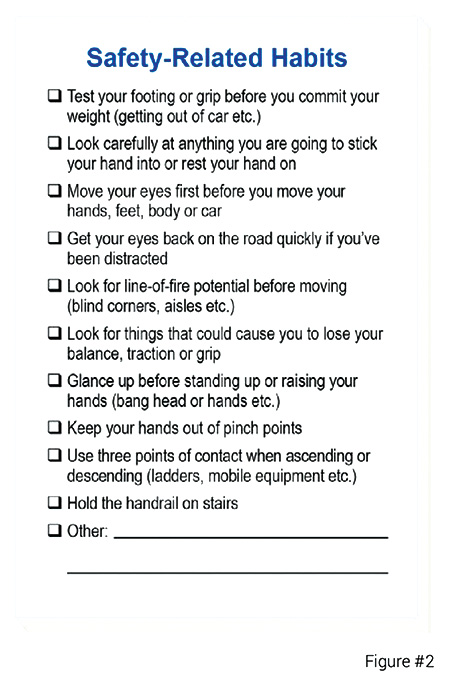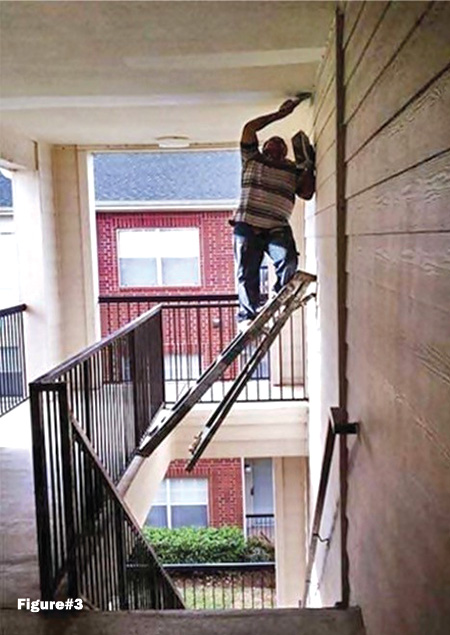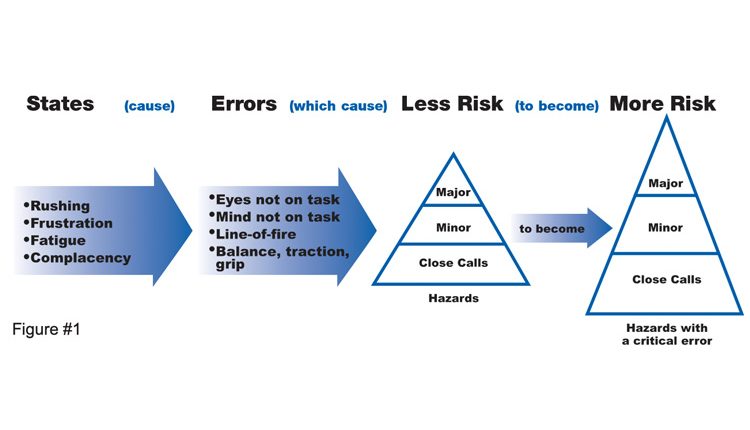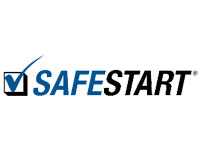The concept of fail-safe is not new, people have been using things like ropes for fall arrest and life jackets in case you fell in the water for 100’s of years. Granted, these devices or pieces of equipment have come a long way over the last one hundred or two hundred years, and typically safety professionals prefer the reliability of these things over the concept of fail-less, which is also not new, which is why you have heard and will continue to hear that “human error is inevitable” or “to err is human.” However, despite the preference for fail-safe, neither concept was ever purported to be absolute or perfect. A seat belt certainly prevents the effects of a driving error from being more severe. But nobody ever said it prevented the vehicle collision in the first place. Similarly, while a fall-arrest harness may prevent a worker from falling to their death, it didn’t prevent the loss of balance, traction or grip that led to the fall.
On the other side of the coin, fail-less is also not new. Athletes, musicians, actors, etc. all practice so they make fewer mistakes while performing. In some cases, they make so few, and the mistakes can be so minor, that nobody sees it or notices it, but rarely do the performers themselves think it was perfect. So as mentioned, absolute perfection when it comes to making something or anything risk free is rarely possible
However, many times the preference for fail-safe in HSE has been because of the “belief” that there is nothing that can be done to eliminate human error, that it is inevitable, etc. And while eliminating human error may not be possible, that doesn’t necessarily mean it can’t be significantly reduced—just like it is with professional athletes or musicians, by providing training and practice until new habits and skills, like “self-triggering” are formed. This will take time and some work or effort. It can be much easier to say, “wear your harness” and “be careful up there.”
Of course, if you weren’t aware that there was anything you could say other than “be careful,” “work safe,” “pay attention,” or “drive safe,” then no wonder you’d emphasize the seat belt, the harness, and the gloves, boots and glasses. But in some cases, like with stairways and handrails, emphasizing the handrail over eyes on task, mind on task, and balance, traction and grip may cause “disquiet” within your workforce. Yes, the handrail is there in case we fail. So if we are holding the handrail we have a better chance, if we lose our balance or miss a step—to fail safe. But it’s obvious to anybody who walks up and down stairs that paying attention: eyes and mind on task—so you don’t lose your balance, traction or grip in the first place is more important. And as a result, disquiet or even resentment can be created (in some cases, a lot of resentment) if you tell people or remind them to hold the handrail when they are going up or down the stairway.
 Case in point: I was speaking at a conference in Vienna, and there was a semi-circular stairway from the conference floor down to the first floor or the lobby/street level. Even though the people (over 150) were all safety professionals, in some cases directors, senior directors or vice-presidents for some of the biggest companies in the world, hardly anyone was holding the handrail. I was at the top of the stairs, commenting on this to a delegate who was amazed and somewhat dismayed by how few people were using the fail-safe device. Just then, the previous speaker, who talked about psychological safety and how we “needed to make it safe for people to speak up”, started running down the stairs. The person I was talking with said, in a fairly loud voice, “handrail”. The look the speaker gave him did not make either of us feel safe about saying anything else. The next day, the same speaker was running down the stairs, only this time I was at the bottom. When I said something about holding the handrail, he gave me the same, “why don’t you mind your own business” look that we saw yesterday. To which I said (probably shouldn’t have) “You’re not making me feel very ‘safe’ speaking up about this”. This time the look was even more hostile, and then he left the hotel and got in a cab, probably (I’m thinking) to go enlighten another audience about the benefits of psychological safety. But the point is, even if it’s not always so dramatic, that certain fail-safe devices and things are not universally preferred, even with safety professionals. And yet, I doubt that this same person would even need to be reminded to wear a seat belt in the cab (enroute to the airport?) or to wear safety glasses if he was in one of their manufacturing areas.
Case in point: I was speaking at a conference in Vienna, and there was a semi-circular stairway from the conference floor down to the first floor or the lobby/street level. Even though the people (over 150) were all safety professionals, in some cases directors, senior directors or vice-presidents for some of the biggest companies in the world, hardly anyone was holding the handrail. I was at the top of the stairs, commenting on this to a delegate who was amazed and somewhat dismayed by how few people were using the fail-safe device. Just then, the previous speaker, who talked about psychological safety and how we “needed to make it safe for people to speak up”, started running down the stairs. The person I was talking with said, in a fairly loud voice, “handrail”. The look the speaker gave him did not make either of us feel safe about saying anything else. The next day, the same speaker was running down the stairs, only this time I was at the bottom. When I said something about holding the handrail, he gave me the same, “why don’t you mind your own business” look that we saw yesterday. To which I said (probably shouldn’t have) “You’re not making me feel very ‘safe’ speaking up about this”. This time the look was even more hostile, and then he left the hotel and got in a cab, probably (I’m thinking) to go enlighten another audience about the benefits of psychological safety. But the point is, even if it’s not always so dramatic, that certain fail-safe devices and things are not universally preferred, even with safety professionals. And yet, I doubt that this same person would even need to be reminded to wear a seat belt in the cab (enroute to the airport?) or to wear safety glasses if he was in one of their manufacturing areas.
So, even though they might not have given it a lot of thought, people are aware that there are two approaches—even if they think “it’s all safety” and just lump both concepts into one “mental file.” But still, there seems to be an attitude or belief that you can only do one, not both, as if it was required that you pick one and you can’t use the other approach at the same time (ex: hold the handrail and pay attention).
Imagine someone saying, “I don’t care if they run down the stairs while they look at their phone—as long as they hold the handrail.” And, even if they didn’t say it out loud, it’s doubtful that they would say the same kind of thing about driving, “I don’t care if they speed and look at their phone—as long as they’re wearing their seatbelt.” We all know how that turned out…
Having a team look at workstations with the aim or one of the objectives being to make them more “error tolerant” or trying to find additional fail-safe opportunities is definitely worth doing. However, this activity can be more productive if everyone involved understands the critical errors that can cause injury and the precursor states or human factors that lead to over 95% of the critical errors, Because, there still might be risks, including significant risks—like falling backwards and hitting your head, neck, etc. that can’t be safeguarded or that lend themselves very readily to fail-safe devices or PPE, etc. (See Fig. 1 – State-to-Error Risk Pattern).
So the “team” should also be looking for the potential for critical errors (moving without looking) and talking about the states that may be causing them, and the critical error reduction techniques that might help. The key to the first CERT is that the states come before the errors: you are tired before you fall asleep at the wheel. This technique, “self-triggering” will work on the first three states: rushing, frustration, and fatigue because you can feel these states in the moment. They are active. Complacency is a passive state. You can’t feel it or how it leads to “mind not on task”. However, if you’re not thinking about what you are doing, your behaviour will be what you do normally, automatically, or habitually. So, if you get in the habit of leaving a safe following distance while driving, then if your mind does go off task, you have at least compensated for your (slightly) slower reaction time if the person ahead of you hits the brakes suddenly. Similarly, if you’re in the habit of holding the handrail, then on the odd occasion where you do miss a step, you will be less likely to fall. There is another benefit as well. When you do have to do something differently, like you need two hands to carry the box down the stairs, the change (to what you do normally) lights up your RAS and makes you pay attention (eyes and mind on task), which helps to keep you from losing your balance, traction or grip in the first place. (See Fig. 2 – Habits)
 Watching others for state-to-error patterns fights complacency in the moment because when you see risk or the potential for an incident – it automatically makes you think about your risk in the moment. (See Fig 3 – Man on ladder above stairway)These CERTs do not replace handrails, seat belts or fall arrest harnesses. They make them less necessary. In other words, by using the techniques, the people fail less, or less often. It doesn’t mean that they won’t ever fail. But now, the team (HOP/other) can look for more than just hazards and protection. They can also look for and talk about the potential for rushing, frustration, fatigue and complacency, or more likely—a combination of those states occurring at the workstation. In some cases, it might be that a certain amount of rushing or fatigue is built into the system in terms of production bonuses causing rushing or lucrative overtime wages causing fatigue. The team can then make recommendations to change the system. In more specific terms, the team may also identify additional safeguards, like rounding the corners of the table at the workstation so that if someone turns without looking then the error is not as likely to cause a laceration. However, now the team can also make suggestions to decrease the rushing—which is contributing to the person turning without looking—and they can recommend that the corners be rounded so that even though the worker is failing less often, they fail to a safe mode or a safer mode. So perhaps a better order, in terms of priority, is fail less/fail safe. First, teach your employees to fail less or make fewer critical errors. Then, get them to fail safe (handrail, seatbelt, harness) if they do still happen to make a critical error.
Watching others for state-to-error patterns fights complacency in the moment because when you see risk or the potential for an incident – it automatically makes you think about your risk in the moment. (See Fig 3 – Man on ladder above stairway)These CERTs do not replace handrails, seat belts or fall arrest harnesses. They make them less necessary. In other words, by using the techniques, the people fail less, or less often. It doesn’t mean that they won’t ever fail. But now, the team (HOP/other) can look for more than just hazards and protection. They can also look for and talk about the potential for rushing, frustration, fatigue and complacency, or more likely—a combination of those states occurring at the workstation. In some cases, it might be that a certain amount of rushing or fatigue is built into the system in terms of production bonuses causing rushing or lucrative overtime wages causing fatigue. The team can then make recommendations to change the system. In more specific terms, the team may also identify additional safeguards, like rounding the corners of the table at the workstation so that if someone turns without looking then the error is not as likely to cause a laceration. However, now the team can also make suggestions to decrease the rushing—which is contributing to the person turning without looking—and they can recommend that the corners be rounded so that even though the worker is failing less often, they fail to a safe mode or a safer mode. So perhaps a better order, in terms of priority, is fail less/fail safe. First, teach your employees to fail less or make fewer critical errors. Then, get them to fail safe (handrail, seatbelt, harness) if they do still happen to make a critical error.
There are many hazards in the world—not just at your workplace—that don’t lend themselves very well to fail-safe options or solutions. In many cases, people need to negotiate these remaining hazards with their eyes and their mind alone, so they can stay out of the line of fire and not lose their balance, traction, or grip (there won’t likely be a handrail when you’re hiking in the woods or in the mountains). However, when they start to work on their self-triggering skills and their safety-related habits, they tend to notice that they still make mistakes. So, even though they might notice that they “fail less”, they also notice that it’s not “never,” which tends to make them appreciate the things like handrails that tend to make them “fail safe.”
– By Larry Wilson
For more information


